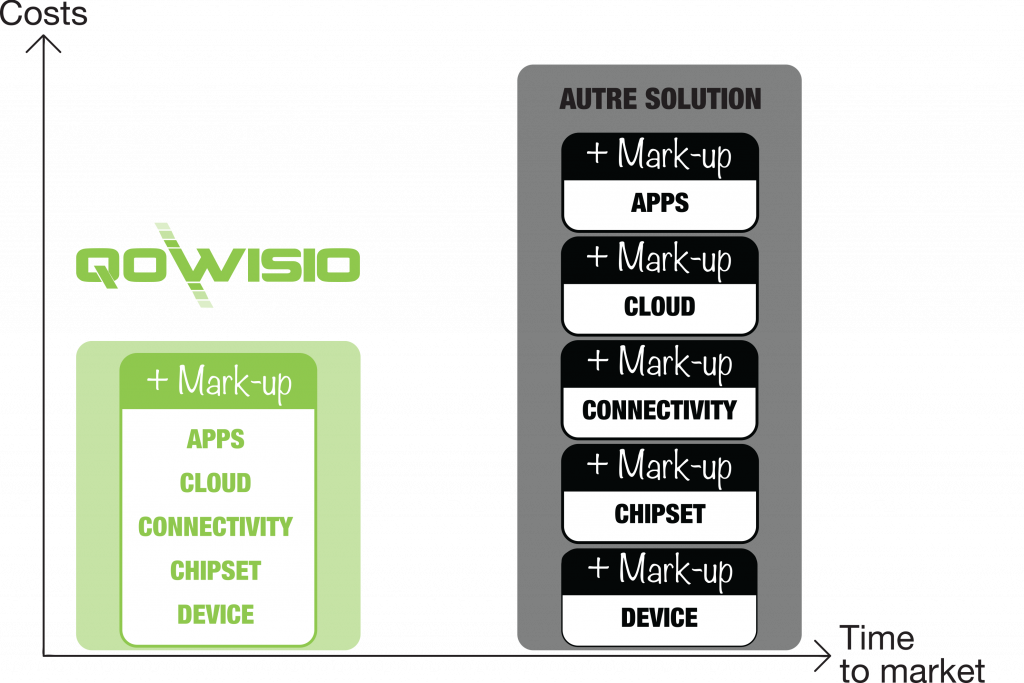Qowisio: the only IoT company with the capacity to target the low-cost connected objects market.
As we explained in a previous article, the IoT (Internet of Things) consists of connecting objects to the Internet. Having been coined as the 3rd Internet revolution, the IoT will be used for more than 20 billion connected objects by 2020.
Objects can be connected to the Internet using different technologies (2G/3G/4G/5G, LTE, Bluetooth, wifi, or LPWA: UNB, LORA, NB-IOT…), with a wide range of options available.
Within the IoT, LPWA technology – UNB (Qowisio & Sigfox) and LoRA in particular – seems to be the most likely to boost the number of connected objects by 2020.
In a recent report, the Arthur D. Little consultancy company reported that the share of objects connected using LPWA solutions looks set to grow by 73% over the next 5 years, and represent around 40% of connections by 2020.
Why is that?
LPWA allows the development of low cost solutions and thus fosters the creation of new uses that have as yet not been economically viable.
The economic benefits from LPWA networks:
- The long range of antennas (up to 60km in rural areas – 2km in urban areas, for UNB) allows LPWA network operators to provide cover for an area with few antennas, so they can limit required investment relative to network cover (in terms of CAPEX and OPEX). Care needs to be taken with the notion of cover though, as we need to distinguish between three different types: outdoor, indoor and deep indoor (such as underground parking areas).
- UNB and LoRA radio technologies use a frequency of 868 Mhz. These are free non-licensed ISM-band frequencies.
In addition, LPWA network operators can offer very low, almost free, connectivity costs (this is the case for some companies like Qowisio: €0.1/year/object).
However, the cost of an IoT solution doesn’t just depend on connectivity costs, since it needs to include two other important components: the cost of the object and the supply of the data.
Essentially, developing an IoT solution requires a range of technical skills in areas such as electronics, on-board software, design, mechanics, the cloud, or even application development.
The IoT value chain is thus particularly complex and fragmented.
So for a company that wants to use an IoT solution, this fragmented value chain will require a number of different companies and this can rapidly become a chain of “stacked margins”, resulting in high costs. This means that it isn’t possible to provide a low cost solution and new uses that could occur based on this principle remain in the pipeline as mere ideas.
Qowisio, through its unique position of working on the full value chain, integrates all skills required for producing a connected solution in order to keep a handle on the full range of costs involved, and thus deliver on a promise of a low TCO (Total Cost of Ownership: the overall price for the solution for a given period of time).
This makes Qowisio the only company on the market that can produce an offer for companies that require connected objects with a very low TCO through a turnkey solution.
The ability to keep this promise means that new uses will now be able to be developed.
> One example is a bike rental company that wanted to be able to perform remote inventories of their bikes, so they could optimize the re-stocking of bike rental stations. Solutions based on GSM were too expensive and didn’t have the required economic model, as well a not being autonomous enough. The turnkey solution from Qowisio, at €60 per bike (TCO over 3 years, or €20 per year per bike with an autonomy of 3 years) allowed the bike rental company’s requirements to be met.
> Another example, in the supply chain sector. Many companies would like to locate their pallets, but given the low face value of the pallets (around €10), no solution had previously been economically viable.
The turnkey solution from Qowisio (at less than €3, TCO over 1 year) allowed the requirements to be met.
> Or we could take the example of a university willing to measure the actual temperature in each of their dorms rooms in order to optimize their energy expenditure. An expensive subscription solution was not economically viable.
The turnkey solution from Qowisio (€40 without subscription, TCO over 5 years) allowed the requirements of the university to be met.
In summary:
LPWA networks significantly contribute to the development of connected objects, since they allow the development of low cost connectivity solutions.
However, the complex and fragmented value chain of the IoT can inhibit the development of new uses.
As such, only companies that can integrate the full value chain are in a position to address the market of connected solutions for under €10, which is a market with great potential for growth.
Qowisio, because of its unique position covering the full value chain, has produced turnkey connected solutions with a very low TCO, and has thus been able to meet the requirements of numerous clients in a range of different sectors.

